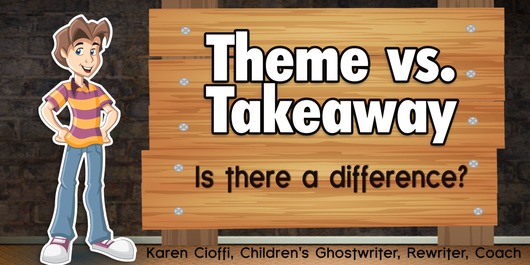
Is there a difference between a story’s takeaway and its theme (message)? If so, what is it?
The answer to the first question is yes; there is a difference between the terms ‘takeaway’ and ‘theme,’ but they’re closely related, so it’s easy to see why writers often confuse the two.
Both elements touch on meaning, both live under the surface of the plot, and both influence how a reader experiences your story. But they are not the same thing.
Understanding the difference will not only make your writing stronger, but it will also help you create stories that linger in the reader’s mind long after the final page.
Let’s break it down.
Yes, theme is a fundamental story element that represents the central idea, message, or meaning of a narrative. It serves as the glue (unifying concept) that ties all other elements together. Common story elements also include plot, characters, setting, and conflict.
WHAT IS A STORY’S THEME?
Theme is a fundamental story element. Think of it as the central idea or message running through your story. It’s what the story is about on a deeper level.
For example, a story may have one of these themes:
• Friendship – the connection between characters and how they rely on one another.
• Forgiveness – the healing that comes from letting go of anger or resentment.
• Courage – standing up to something frightening or overwhelming.
• Greed – the damage it can cause to people or relationships.
Theme is the BIG idea. You don’t usually spell it out word-for-word on the page. Instead, it’s woven into the characters’ actions, the conflicts, and the resolution.
Readers may describe your book in one sentence based on its theme: It’s a story about coming of age, finding your own voice, or environmental awareness.
Theme is broad and universal; it gives your story depth and resonance. It’s what makes a tale more than just a string of events.
WHAT IS A STORY’S TAKEAWAY?
The takeaway is specific and individual. It’s about the reader—the personal meaning or insight the reader gains after finishing your story.
Think of takeaway as the “aha” moment your book leaves behind. It may be subtle, or it may be powerful enough to shift the way a reader sees their life or the world.
Some examples of takeaways could be:
• Even small acts of kindness can change someone’s life.
• You don’t have to be perfect to be loved.
• Courage doesn’t mean not being afraid; it means acting anyway.
• Dishonesty destroys friendships and other relationships.
Notice how each one sounds like a lesson or realization. That’s because the takeaway is often expressed as wisdom the reader carries forward.
HOW THEME AND TAKEAWAY WORK TOGETHER
A good way to think about it is this:
• Theme is the story’s heartbeat; the steady rhythm under everything.
• Takeaway is like an echo; it lingers with the reader after the book closes.
Here’s an example.
Imagine you’re writing a chapter book about a girl who wants to win a science fair. She struggles, makes mistakes, and eventually learns to ask for help from a classmate.
• Theme: Teamwork and perseverance.
• Takeaway: Working with others doesn’t make you weaker; it makes you stronger.
Here’s another example:
A YA novel follows a boy who steals to support his family but is eventually caught.
• Theme: Choices and consequences.
• Takeaway: Doing the right thing, even when it’s hard, builds character and respect.
See the difference? The theme is the universal idea in the story, while the takeaway is how it applies to the reader, the personal lesson the reader pulls from that idea.
WHY WRITERS NEED BOTH
If your story only has a theme, it may feel like an idea without impact. If it only has a takeaway, it may feel like a lecture. But when the two work together, you create a story that’s both meaningful and memorable.
Here’s how:
- Theme guides your writing. As you build characters and plot, the theme helps you stay focused on the story. If your theme revolves around greed and laziness, you’ll create conflicts and choices that emphasis these characteristics and their consequences.
- Takeaway inspires your reader. The reader doesn’t just close the book and move on; they leave with a new perspective, a piece of wisdom, or encouragement that applies to their own life.
That’s the magic combination.
TIPS FOR WRITERS
- Identify your theme early. Ask yourself, What is this story really about at its core?
- Show, don’t tell. Let your characters’ actions, struggles, consequences, and achievements reveal the theme, rather than spelling it out.
- Think about the reader. After the last page, what do you hope they’ll carry with them? That’s your takeaway.
- Don’t hit the reader over the head. A takeaway shouldn’t feel like a lecture or a moral slapped on the end. It should grow naturally (reveal itself) from the characters’ journey.
- Read your story aloud. When you finish, ask yourself: What does this story leave me with? That’s often the takeaway your readers will feel, too.
SUMMING IT UP
Theme and takeaway are closely related, but they serve different purposes. Theme belongs to the story. Takeaway belongs to the reader. When you understand how they differ and how they work together, you’ll be able to craft stories that matter.

Should Picture Book Authors Create Storyboards?
10 Difficulties Common to New Novelists
Self-Publishing: Why Use Your Own ISBNs

I’m a working children’s ghostwriter, rewriter, and coach. I can help turn your story into a book you’ll be proud to be the author of, one that’s publishable and marketable.
OTHER HELP I OFFER:
HOW TO WRITE A CHILDREN'S FICTION BOOK
A DIY book to help you write your own children’s book.
https://www.amazon.com/How-Write-Childrens-Fiction-Book/dp/0999294911/ref=sr_1_1
FICTION WRITING FOR CHILDREN eCOURSE
4-Weeks / 8 Sections Guided Self-Study Program
You can contact me at kcioffiventrice@gmail.com.
